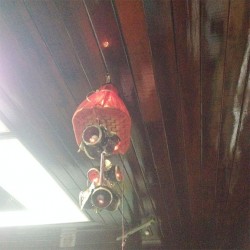A chandelier made of coconut shells and a bag made of banana fibres and egg trays were among the innovations on display on Thursday when Carnegie School of Home Economics students proved true the old adage, “One man’s trash is another man’s treasure.”
The students were at the time participating in a preliminary round of the Council for Technical and Vocational Education and Training’s Technological Skills Competition, where they competed against each other for the chance to represent the school nationally in the second round of the competition, scheduled for June 30th, 2015 at Queen’s College.
The competition is being held for technical and vocational institutions in order to select participants for the FETEPS Technological Fair, slated for September in Sao Paolo, Brazil. The theme of the fair is “Industrial Technology (Solid Waste Management),” and Thursday’s competition saw the ingenuity of the participants reflected by the pieces on display. This was accompanied by oral presentations, which served to enlighten the seemingly intrigued spectators on how one could make such beautiful creations from items that are commonly discarded as garbage.
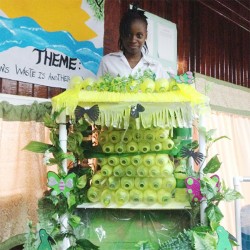
Each piece was presented under different themes, some of which tried to capture the imagination. One such piece was a replica of the Carnegie School created from crushed egg shells. This piece was presented by Tenegue Boyce and Sheresce Black, under the theme “One Hen, Her Eggs, Our Creation.” The proud students were very vocal about the hard work that was put into completing their work of art and credited their success to team work and great communication.
Another display showcased how grated coconut can be made into a delightful treat after being squeezed of its ‘milk.’ The young students present related how the grated substance, which many deem useless after utilising the coconut milk, can be turned into a sweet treat by simply adding sugar-based condiments to it. They dubbed the treat ‘Deliete Cocochoco.’
The criteria for judging covered a range of categories, including the group’s choice of project in keeping with the theme of the competition, functionality and feasibility of project, creativity and originality as well as the oral presentation given by the participants.
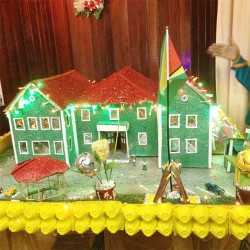
At the end, prizes were awarded to the top three participants. The position of first place, along with a trophy and $30,000 cash, was awarded to “Tropical Waterfall”- a simple yet creative piece which saw the use of PVC pipes and water bottles to create a miniature waterfall. This piece was presented by several female students of the institute. When asked about the rationale behind using plastic bottles as their item of choice, the winners stated that plastic bottles are one of the most commonly discarded items in our country today. As a result, they thought it would be interesting to give the public an example of how these bottles can be recycled.
Second place, along with a trophy and $20,000 cash, was awarded to a piece displayed under the name ‘Noix de Coco Chandelier.’ The elegantly designed chandelier, which hung from the ceiling, was made from coconut shells which the students polished using floor sheen and wood varnish.
Last, but by no means least, was a fashion bag creatively constructed using mainly cardboard, foam sponge, banana fibres and egg trays. This was proudly displayed by Lashawn Larose and Shannon Vasconcellos, both of whom boasted about the potential fashion statement one could make walking around with such a bag. They were awarded a trophy and $10,000 cash.
Other pieces presented included, “Plastic with purpose”, which displayed how creative one can get with plastic bottles and spoons as they showcased a vase, jewelry and a night lamp, all of which were made from plastic
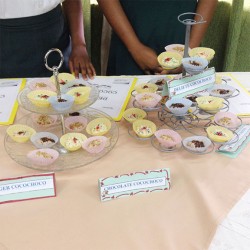
based items.
The competition sought not only to awaken the creativity of the students in relation to solid waste management but to also build and strengthen skills in areas such as teamwork, self-esteem and communication.
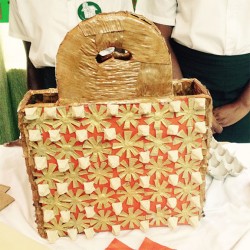
The winner of the competition will go on to the second leg of the competition where they will be competing with several other institutions across the country for the opportunity to represent Guyana at the final leg of the competition, slated for September in Sao Paula, Brazil.
